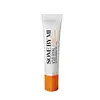What's inside
What's inside
 Key Ingredients
Key Ingredients

 Benefits
Benefits

 Concerns
Concerns

 Ingredients Side-by-side
Ingredients Side-by-side

Zinc Oxide 16.5%
Cosmetic ColorantPolybutene
Caprylic/Capric Triglyceride
MaskingHelianthus Annuus Seed Wax
Skin ConditioningC9-12 Alkane
SolventDiisostearyl Malate
EmollientEuphorbia Cerifera Wax
Tridecyl Trimellitate
EmollientBis-Behenyl/Isostearyl/Phytosteryl Dimer Dilinoleyl Dimer Dilinoleate
EmollientGlyceryl Isostearate
EmollientHydrogenated Polyisobutene
EmollientDimethicone
EmollientButyrospermum Parkii Butter
Skin ConditioningBis-Diglyceryl Polyacyladipate-2
EmollientZea Mays Oil
EmulsifyingPolyhydroxystearic Acid
EmulsifyingLecithin
EmollientAscorbic Acid
AntioxidantAcetyl Glucosamine
Skin ConditioningLinoleic Acid
CleansingPunica Granatum Sterols
Skin ConditioningDipalmitoyl Hydroxyproline
Skin ConditioningDisteardimonium Hectorite
StabilisingSqualane
EmollientPolysilicone-11
Sodium Hyaluronate
HumectantTocopheryl Acetate
AntioxidantPalmitoyl Tripeptide-1
Skin ConditioningPalmitoyl Tetrapeptide-7
Skin ConditioningMoringa Oil/Hydrogenated Moringa Oil Esters
Skin ConditioningAmaranthus Caudatus Seed Oil
EmollientHordeum Distichon Extract
Skin ProtectingTriticum Vulgare Germ Oil
EmollientTriethyl Citrate
MaskingCitrus Aurantium Peel Oil
Aroma
C12-15 Alkyl Benzoate
AntimicrobialRicinoleic Acid
CleansingVanillin
MaskingSorbitan Laurate
EmulsifyingC18-36 Acid Glycol Ester
EmollientC18-36 Acid Triglyceride
EmollientTocopherol
AntioxidantBlue 1 Lake
Cosmetic ColorantCI 77491
Cosmetic ColorantCI 77492
Cosmetic ColorantCI 77499
Cosmetic ColorantCI 15850
Cosmetic ColorantCI 45380
Cosmetic ColorantCI 19140
Cosmetic ColorantZinc Oxide 16.5%, Polybutene, Caprylic/Capric Triglyceride, Helianthus Annuus Seed Wax, C9-12 Alkane, Diisostearyl Malate, Euphorbia Cerifera Wax, Tridecyl Trimellitate, Bis-Behenyl/Isostearyl/Phytosteryl Dimer Dilinoleyl Dimer Dilinoleate, Glyceryl Isostearate, Hydrogenated Polyisobutene, Dimethicone, Butyrospermum Parkii Butter, Bis-Diglyceryl Polyacyladipate-2, Zea Mays Oil, Polyhydroxystearic Acid, Lecithin, Ascorbic Acid, Acetyl Glucosamine, Linoleic Acid, Punica Granatum Sterols, Dipalmitoyl Hydroxyproline, Disteardimonium Hectorite, Squalane, Polysilicone-11, Sodium Hyaluronate, Tocopheryl Acetate, Palmitoyl Tripeptide-1, Palmitoyl Tetrapeptide-7, Moringa Oil/Hydrogenated Moringa Oil Esters, Amaranthus Caudatus Seed Oil, Hordeum Distichon Extract, Triticum Vulgare Germ Oil, Triethyl Citrate, Citrus Aurantium Peel Oil, Aroma, C12-15 Alkyl Benzoate, Ricinoleic Acid, Vanillin, Sorbitan Laurate, C18-36 Acid Glycol Ester, C18-36 Acid Triglyceride, Tocopherol, Blue 1 Lake, CI 77491, CI 77492, CI 77499, CI 15850, CI 45380, CI 19140
Bis-Diglyceryl Polyacyladipate-2
EmollientPolyglyceryl-2 Isostearate/Dimer Dilinoleate Copolymer
EmollientDiisostearyl Malate
EmollientHydrogenated Castor Oil Isostearate
Skin ConditioningEthylhexyl Methoxycinnamate
UV AbsorberPentaerythrityl Tetraisostearate
EmollientBis-Behenyl/Isostearyl/Phytosteryl Dimer Dilinoleyl Dimer Dilinoleate
EmollientHydrogenated Polyisobutene
EmollientPhytosteryl/Isostearyl/Cetyl/Stearyl/Behenyl Dimer Dilinoleate
Skin ConditioningTocopheryl Acetate
AntioxidantEthylhexyl Salicylate
UV AbsorberEuphorbia Cerifera Cera
AstringentCaprylic/Capric Triglyceride
MaskingMicrocrystalline Wax
Emulsion StabilisingCitrus Limon Peel Oil
MaskingCitrus Aurantium Dulcis Peel Oil
MaskingOlea Europaea Fruit Oil
MaskingGlyceryl Behenate/Eicosadioate
EmollientGlycerin
HumectantWater
Skin ConditioningPolyglyceryl-10 Stearate
Skin ConditioningPanthenol
Skin ConditioningSodium Ascorbyl Phosphate
AntioxidantNiacinamide
SmoothingRetinyl Palmitate
Skin ConditioningBiotin
AntiseborrhoeicThiamine Hcl
MaskingFolic Acid
Skin ConditioningPyridoxine
Skin ConditioningCyanocobalamin
Skin ConditioningDehydroacetic Acid
PreservativeLimonene
PerfumingBis-Diglyceryl Polyacyladipate-2, Polyglyceryl-2 Isostearate/Dimer Dilinoleate Copolymer, Diisostearyl Malate, Hydrogenated Castor Oil Isostearate, Ethylhexyl Methoxycinnamate, Pentaerythrityl Tetraisostearate, Bis-Behenyl/Isostearyl/Phytosteryl Dimer Dilinoleyl Dimer Dilinoleate, Hydrogenated Polyisobutene, Phytosteryl/Isostearyl/Cetyl/Stearyl/Behenyl Dimer Dilinoleate, Tocopheryl Acetate, Ethylhexyl Salicylate, Euphorbia Cerifera Cera, Caprylic/Capric Triglyceride, Microcrystalline Wax, Citrus Limon Peel Oil, Citrus Aurantium Dulcis Peel Oil, Olea Europaea Fruit Oil, Glyceryl Behenate/Eicosadioate, Glycerin, Water, Polyglyceryl-10 Stearate, Panthenol, Sodium Ascorbyl Phosphate, Niacinamide, Retinyl Palmitate, Biotin, Thiamine Hcl, Folic Acid, Pyridoxine, Cyanocobalamin, Dehydroacetic Acid, Limonene
 Reviews
Reviews

Alternatives
Ingredients Explained
These ingredients are found in both products.
Ingredients higher up in an ingredient list are typically present in a larger amount.
We don't have a description for Bis-Behenyl/Isostearyl/Phytosteryl Dimer Dilinoleyl Dimer Dilinoleate yet.
This ingredient is lipid-based synthetic skin-conditioning agent derived from adipic acid and a mixture of fatty acids. It is often called a lanolin substitute.
As an emollient, it helps soften and hydrate the skin. Emollients create a barrier on the skin to trap moisture in.
Due to its fatty acid base, it may not be Malassezia folliculitis safe.
Learn more about Bis-Diglyceryl Polyacyladipate-2This ingredient is an emollient, solvent, and texture enhancer. It is considered a skin-softener by helping the skin prevent moisture loss.
It helps thicken a product's formula and makes it easier to spread by dissolving clumping compounds.
Caprylic Triglyceride is made by combining glycerin with coconut oil, forming a clear liquid.
While there is an assumption Caprylic Triglyceride can clog pores due to it being derived from coconut oil, there is no research supporting this.
Learn more about Caprylic/Capric TriglycerideDiisostearyl Malate is an emollient and most often used in lip products. It comes from isostearyl alcohol, a fatty acid, and malic acid, an AHA.
As an emollient, Diisostearyl Malate helps create a thin film on your skin to trap moisture in. This helps keep your skin soft and smooth.
Hydrogenated Polyisobutene is a synthetic polymer. Polymers are compounds with high molecular weight. Hydrogenated Polyisobutene is an emollient and texture enhancer.
In one study, Hydrogenated Polyisobutene showed better skin hydration levels than Caprylic/Capric Triglyceride. As an emollient, it helps keep your skin soft and hydrated by trapping moisture in.
Hydrogenated Polyisobutene is often used as a mineral oil replacement.
Learn more about Hydrogenated PolyisobuteneTocopheryl Acetate is AKA Vitamin E. It is an antioxidant and protects your skin from free radicals. Free radicals damage the skin by breaking down collagen.
One study found using Tocopheryl Acetate with Vitamin C decreased the number of sunburned cells.
Tocopheryl Acetate is commonly found in both skincare and dietary supplements.
Learn more about Tocopheryl Acetate